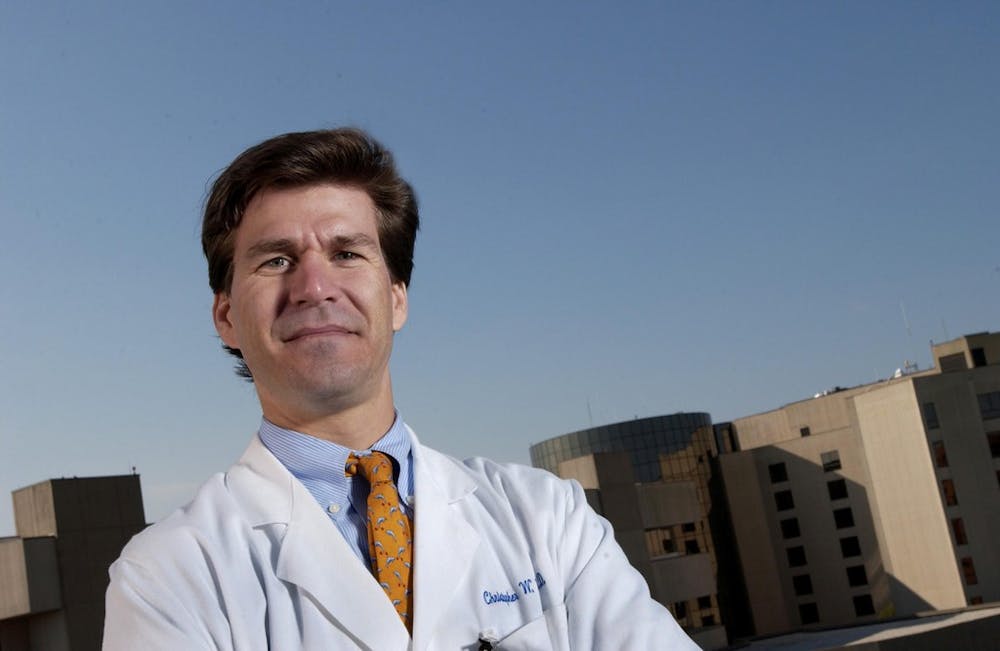Chris Woods is a professor of medicine and global health and co-director of Duke’s Hubert-Yeargan Center for Global Health. The Chronicle spoke to him about how students should stay healthy, keep others safe and support each other during the COVID-19 pandemic. This interview has been lightly edited for length and clarity.
The Chronicle: How can students in dorms practice social distancing, even though they share common spaces like bathrooms and rooms with other people?
Chris Woods: The main thing is going to be when one is sick, try to step out of the social world. True social distancing when people are asymptomatic on a college campus is going to be difficult. You’re living with multiple people in a dorm room and you tend to share all kinds of things, and so I’m hoping that come next year, we won’t see that second bump in the fall or something, and college life won’t have to make some huge change.
It’d be very hard to achieve true social distancing on a college campus with any kind of normal college existence. Other than that, identifying when someone is getting sick early and kind of distancing oneself at that point can have a lot of good side benefits. In watching you guys for several years, cohorts of first-years in particular, on average you guys would have between four and five respiratory infections in a year. If you think about it, if people start living a little differently, you might start living a little healthier—which would be a good thing!
TC: What would you say to college students and people who are still going out to beaches and other nonessential places?
CW: We are in a time where it is unprecedented for my generation and certainly for your generation in some ways. There are elements that are like the old SARS or elements that are like the 2009 pandemic. The last time, in 2009, the vulnerable population was adolescents and young adults for some reason. Many of them had very severe manifestations and there was a lot of activity in place to try to protect that population but the attack rate, or the case fatality rate, was nothing like what we see with the older folks and COVID-19.
So I would hope that everyone would feel some sense of responsibility and would want to work together to limit the spread. If we get too many people having severe manifestations of it all at once, it just makes it very hard on the hospital system. That’s what everyone talks about: “flattening the curve.” That’s all about keeping within the current capacity of our health system because when you start to outstretch that, the case fatality rates start to go up. Follow the guidance that we’re getting from our public health infrastructure. Limit unnecessary contact and find other ways to be social and communicate.
TC: So, the Centers for Disease Control and Prevention put out guidelines that put a cap on gatherings at 10 people. What does that mean for us exactly?
CW: In Durham, we have a shelter-in-place order, which goes one step further. No gatherings other than family gatherings, and you’re supposed to stay 6 feet apart and all of those types of things. It’s a little more drastic.
The gatherings are somewhat arbitrary cutoffs, but all of them are seeking to interrupt the social networks, the physical social networks that allow for transmission to take place. The more we can do that, the more likely we are to succeed in flattening the curve.
I’m not going to give you permission to go to 11. I’m not going to say you’re okay at nine. A lot of that depends on what the situation is. For the most part, Duke students should be smart enough to figure out when they may be technically OK but probably not doing the right thing.
TC: If you have travel for an upcoming summer internship or something else, and the virus is still going around, how do you stay safe?
CW: Just know the situation you’re going into. Maintain that situational awareness. Pay attention to ongoing reports if there is evidence of new disease or if there is disease activity popping up. Being sure that if you were to get sick, you have a plan in place to either be taken care of locally or that you have a way to get to where you need to be to receive care. Duke does a good job of making sure there are mechanisms to get you back and there are support systems to have you cared for if you need. You have all these great social distancing skills you’ve picked up along the way, so if there is evidence of ongoing transmission, you can continue to practice your good hand hygiene and try not to get into crowded situations.
TC: So the overwhelming message I’m getting is take personal responsibility and use good judgement.
CW: Yes. (Laughs.) That’s a very good summary of what I’m trying to say.
TC: How can Duke students promote practices outlined by experts?
CW: It’s one of those great national tragedies. It’s a global tragedy. And people are trying to figure out how you do what you’re supposed to do, which is to be distanced from one another, yet support one another. You guys at Duke, you all are people who want to solve problems. You’re high energy. You’re thinkers, engineers, poets. You’re thinking creatively about how to make the world a better place. And I would encourage you to keep doing that. Hopefully as we get a little further into this and as we come out of it, there will be more obvious ways to participate in protecting one another.
TC: What do you expect the timeline to look like, before things go back to normal?
CW: I’m hoping we won’t actually have to deal with a COVID-19 issue in the Fall semester, but I think most people expect that there’ll be some element of it still around. I’m hoping it just becomes part of a standard respiratory viral season, kind of like H1N1, the virus that causes swine flu. You guys may not even realize it, but in 2009, that initial year was really scary for folks. But then subsequent to that, H1N1 was our standard virus every year in the flu season until recently, when the H3s and H2s have come back. If it just enters into the cyclical respiratory viruses with other coronaviruses, it may weaken and not be such a threat to our vulnerable populations and hopefully we can achieve some normal life.
What’s amazing to me is that you do shed this virus for a long period of time, even before you’re ill and after you’re ill, so there’s this long potential to continue to spread it to folks. Unless it disappears into the background, there’ll be some reservoirs of people who are likely to reintroduce it into the population, so I wouldn’t be surprised if it does reenter. The question will be does it have some modifications and if it becomes more like one of the typical coronaviruses that we see, which are basically just cold viruses.
TC: Is that then what you think is what sets this novel coronavirus apart from others, is the fact that you are transmitting it for so long without knowing you have it?
CW: I think what really distinguishes it is there’s basically no case fatality with the coronaviruses that are seasonal coronaviruses. Occasionally, it’ll trigger an asthma flare, or someone who has an obstructive pulmonary disease will have a bad outcome with it, but what really distinguishes COVID-19 is the severe pneumonia and what we call ARDS, or acute respiratory distress syndrome. That manifestation is distinct. Tie that with the fact that people are more likely to be shedding it for these long periods of time, and then it becomes a very scary virus. Then you add the third part of it—that no one has immunity to it. Because everyone is susceptible to it, it’s going to have some bad outcomes for folks.
TC: How would you suggest that we stay connected while disconnected?
CW: Truthfully, you guys are better at that than anyone in my generation. Whatever the current mechanisms are, you guys are experts at doing it. I think you just need to be mindful—reaching out to those people who you may not see participating and checking in on them and making sure they’re doing OK. Certainly if family or friends are becoming ill, reach out to them. This is a time for people working together and supporting one another.
Get The Chronicle straight to your inbox
Signup for our weekly newsletter. Cancel at any time.

Preetha Ramachandran is a Trinity senior and diversity, equity and inclusion coordinator for The Chronicle's 118th volume. She was previously senior editor for Volume 117.

